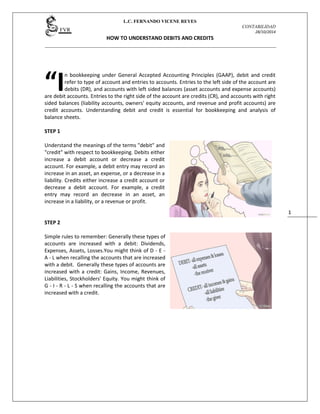Credits and debits
•
1 like•859 views
Credits and debits
Report
Share
Report
Share
Download to read offline

Recommended
Recommended
More Related Content
What's hot
What's hot (16)
Accounting Cycle - Trial Balance - Easy Accounting

Accounting Cycle - Trial Balance - Easy Accounting
presentation slide on Accounting General ledger & trial balance

presentation slide on Accounting General ledger & trial balance
20100726090748 chapter 4 the effect of p&l on capital

20100726090748 chapter 4 the effect of p&l on capital
Viewers also liked
Viewers also liked (11)
Similar to Credits and debits
Similar to Credits and debits (20)
Fundamentals of Business Mathematics in Canada Canadian 2nd Edition Jerome So...

Fundamentals of Business Mathematics in Canada Canadian 2nd Edition Jerome So...
ANALYZING TRANSACTIONS INTO DEBIT AND CREDIT PARTS.docx

ANALYZING TRANSACTIONS INTO DEBIT AND CREDIT PARTS.docx
Accounting Cycle - Ledgers - Capturing accounting event

Accounting Cycle - Ledgers - Capturing accounting event
More from L.C. Fernando Vicente Reyes
More from L.C. Fernando Vicente Reyes (9)
Recently uploaded
Mehran University Newsletter is a Quarterly Publication from Public Relations OfficeMehran University Newsletter Vol-X, Issue-I, 2024

Mehran University Newsletter Vol-X, Issue-I, 2024Mehran University of Engineering & Technology, Jamshoro
Recently uploaded (20)
This PowerPoint helps students to consider the concept of infinity.

This PowerPoint helps students to consider the concept of infinity.
Measures of Central Tendency: Mean, Median and Mode

Measures of Central Tendency: Mean, Median and Mode
Unit-IV; Professional Sales Representative (PSR).pptx

Unit-IV; Professional Sales Representative (PSR).pptx
ICT Role in 21st Century Education & its Challenges.pptx

ICT Role in 21st Century Education & its Challenges.pptx
Presentation by Andreas Schleicher Tackling the School Absenteeism Crisis 30 ...

Presentation by Andreas Schleicher Tackling the School Absenteeism Crisis 30 ...
Seal of Good Local Governance (SGLG) 2024Final.pptx

Seal of Good Local Governance (SGLG) 2024Final.pptx
Credits and debits
- 1. L.C. FERNANDO VICENE REYES CONTABILIDAD 28/10/2014 HOW TO UNDERSTAND DEBITS AND CREDITS 1 n bookkeeping under General Accepted Accounting Principles (GAAP), debit and credit refer to type of account and entries to accounts. Entries to the left side of the account are debits (DR), and accounts with left sided balances (asset accounts and expense accounts) are debit accounts. Entries to the right side of the account are credits (CR), and accounts with right sided balances (liability accounts, owners' equity accounts, and revenue and profit accounts) are credit accounts. Understanding debit and credit is essential for bookkeeping and analysis of balance sheets. STEP 1 Understand the meanings of the terms "debit" and "credit" with respect to bookkeeping. Debits either increase a debit account or decrease a credit account. For example, a debit entry may record an increase in an asset, an expense, or a decrease in a liability. Credits either increase a credit account or decrease a debit account. For example, a credit entry may record an decrease in an asset, an increase in a liability, or a revenue or profit. STEP 2 Simple rules to remember: Generally these types of accounts are increased with a debit: Dividends, Expenses, Assets, Losses.You might think of D - E - A - L when recalling the accounts that are increased with a debit. Generally these types of accounts are increased with a credit: Gains, Income, Revenues, Liabilities, Stockholders' Equity. You might think of G - I - R - L - S when recalling the accounts that are increased with a credit. “I
- 2. L.C. FERNANDO VICENE REYES CONTABILIDAD 28/10/2014 HOW TO UNDERSTAND DEBITS AND CREDITS 2 STEP 3 Remember that the books must always be kept in balance so that every debit entry must be accompanied by a corresponding credit entry, and vice versa. This is the standard double-entry bookkeeping system. STEP 4 Set up the balance sheet with all debit accounts on the left and credit accounts on the right. For illustration, assume that ABC Company has $5000 cash, $7000 inventory, $3000 capital stock, and $9000 surplus. The balance sheet would be as follows: STEP 5 Set up the ledgers (the books for record-keeping) for each account. Place the debit balance on the left and the credit balance credit on the right. Remember that debit accounts have debit balances and credit accounts have credit balances. For our example, the ledgers would appear as follows: STEP 6 For each transaction, consider what is being exchanged for what, which debit account it affects and whether the effect is to increase or to decrease. Does it change the amount of cash, the amount of receivables, the inventory, amount of properties, or an expense? If the transaction increases a debit account, record a debit entry in that debit account, and simultaneously a credit entry in an appropriate credit account. If the transaction decreases a debit account, record a credit entry in that debit account, and
- 3. L.C. FERNANDO VICENE REYES CONTABILIDAD 28/10/2014 HOW TO UNDERSTAND DEBITS AND CREDITS 3 simultaneously a debit entry in an appropriate credit account. Suppose the company in our example has subsequently sold on credit $4000, which cost it $2800, and incurred various expenses totalling $500 paid in cash. The $4000 sold on credit increases Accounts Receivables, and is therefore a debit entry. For simplicity, let us log all profit and loss as credit or debit in the Surplus account. Thus, the debit entry of $4000 under Receivables would have a corresponding credit entry of $4000 under Surplus. The cost of goods sold of $2800 decreases the inventory, and is therefore a credit entry. It will have a corresponding $2800 debit entry from Surplus. The $500 expenses paid in cash decreases Cash account, and is therefore a credit entry. It will have a corresponding $500 debit entry from Surplus. These entries are recorded as follows. STEP 7 Calculate the ending balance in each account and update the balance sheet. The example given would be as follows: STEP 8 Check that the books are balanced again.” WEB: http://www.wikihow.com/Understand-Debits-and-Credits TEXT IS COMPLETELY THE, ABOVE, WEBSITE
